My Minidisc-Story
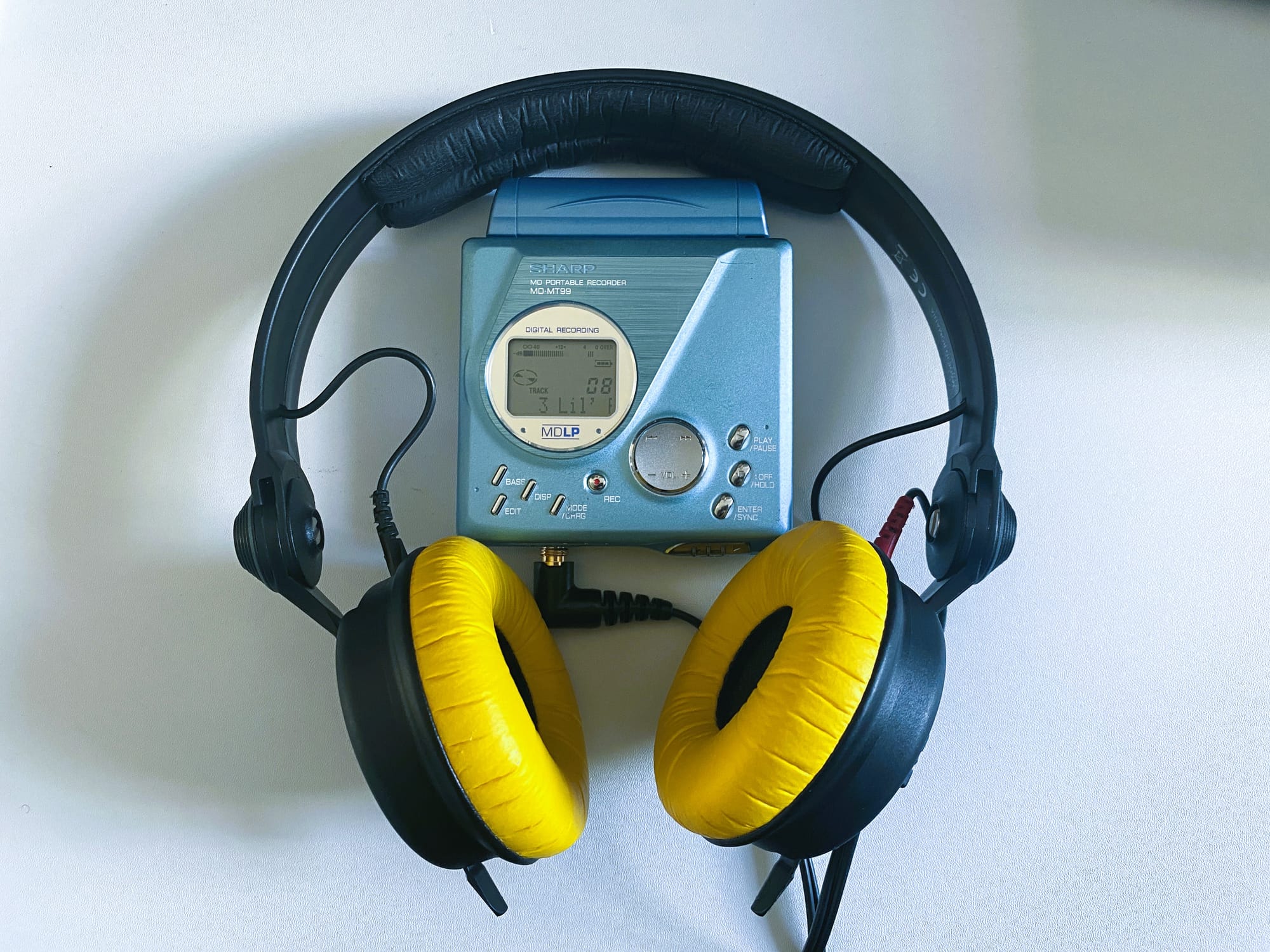
This is my Minidisc-Story
Back in the year 2000 (haha, sounds like a bad intro into a cheap SciFi-novel), my journey with Minidisc began...
It was the days, in which Rage Against the Machine, Absolute Beginner and Patrice where the contemporary bands to listen to. As I already had a pretty decent Stereo-System, consisting of a Technics Amp, paired with Canton speakers, I wanted to have the same quality of sound on the go. Therefore, I purchased a Sharp MD-MT99. Why? Simply, because this unit was available in blue. Yes, that is the real and only reason. This device was my first portable Minidisc-Recorder. The list of features was and still is pretty nice: Metal body, MDLP (longplay mode), optical-in, Mic-in, works with one standard AA-battery for ages. Yes, the form-factor is unique, but I was okay with it. The notch on top, which houses the battery breaks the square design, but it also makes the device pretty flat, so the recorder can slide in your back pocket without any issues.
I spent tens of hours in front of my CD-Player, recording music onto Minidiscs, taking them with me on the go to school. As I had a Philips over-ear headphone, the isolation was really good and I enjoyed my music a lot. This was also the time, I got into playing the electric guitar and had my first band called "suffering cross", but this is a different story...
The mic-in of the recorder came in handy, too, as I was able to record our first demo onto Minidisc, using the headphone as a microphone (yes, you can do that).
Times flew by like crazy and my most listened-to album was "The Battle of L.A." by Rage against the Machine.
Then, suddenly, it all stopped. Unfortunately, my beloved Sharp Minidisc Recorder didn't work anymore. All it did was showing the error-message "can't READa".
Too bad I thought, so I went to the next electronics shop to purchase a new Minidisc-Recorder. This time, I gave the Sony MZ-N505 a go. Why this particular model? You are guessing correctly: because it was available in blue.
This device was different then the Sharp. I was all plastic, had the battery at the back, which was not only ugly, but also a bit clunky, and it came with a USB-interface.
USB on such a recorder? Yes, it was the time, where MP3s became very popular and Sony implemented an approach to copy MP3s onto Minidiscs via USB using a dedicated Software, called "SonicStage". Once imported, it was possible to check-out MP3s and copy them onto the recorder, just like files on later MP3-players, but with the advantage to have them stored on a physical disc, being able to listen to it on a stereo-system.
This was a huge game-changer for me!
Nevertheless, due to the plastic-made shell, the MZ505 did not last as long as the Sharp.
Very sadly, the Sony broke, as I fell down with my bike onto my bum, having the MZ505 in my back pocket. Outch!
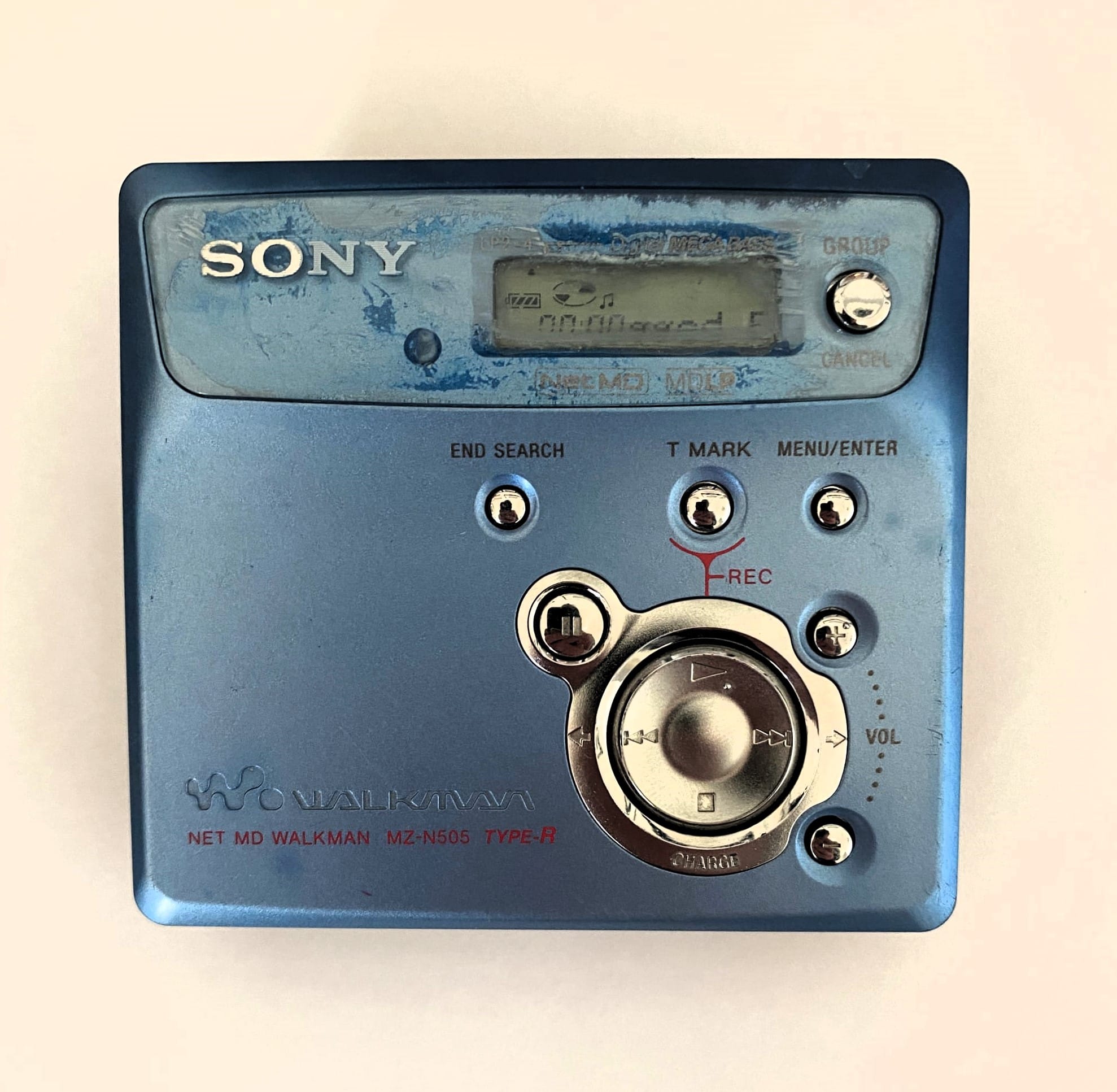
And this was it with Minidisc... I thought.
Then, I moved over to MP3-Players. I had a couple of those, incl. the ones with an integrated USB-A plug. I also had a Creative Zen Pebble, which came with an integrated speaker, but one of my mates in Australia lost it unfortunately. This was the trigger to purchase an iPod. It was an iPod nano in - of course - blue.

The metal case was even engraved with my blog-URL back then (3springs | _benedicht.de), as I had the opportunity to experience three springs in a row. (I did an exchange semester in Melbourne, Australia).
For good listening quality, I got a Sennheiser PX-100 in white, which is a pair of on-ear headphones, which looked like the original Sony Walkman headphone. Actually, I got asked about it several times...
Back in Germany, I was very interested in audiophile music and listening, but with a limited budget, I was not able to acquire any decent portable hardware like Astell&Kern etc.
That is why my girlfriend back then, now wife, gave me a Fiio X1 as a Christmas present. This is a MP3-player, which also was able to play back FLAC-files and even Waves (.flac == free lossless audio codec and .wav == uncompressed audio files).

This tiny little player was really good, as it fitted my needs of being able to listen to high-quality music on the go. I exchanged the headphones with Bang&Olufsen H2s, a pair of really premium made headphones in dark blue...
This setup lasted for a while, but then I realized, having three different headphones on my desk at work is simply too much (one for music coming to the office, one for the desk-phone and one for the computer for video-calls).
This is, when I started to concentrate on consolidation.
Why do I need three headphones, and how can I condense it down to one?
Well, it was easier than expected. First action was to get rid of my desktop-phone. I was able to set up a forwarder to my mobile and this kind of indicates, the center of portable music was turning towards the iPhone.
So now, the only thing left was to combine listening to music with a headset and also to conduct online video-calls.
The answer came to me at an event in the Microsoft office in Munich:
While attending the official start of Microsoft Teams in Germany, there was a booth from Plantronics (now Poly) down in the hall and I had a nice chat with the lady, presenting the devices.
The result was, I bought a Plantronics Focus Voyager bluetooth headset with active noise-cancelling, which was able to connect to two devices at the same time: my iPhone and my computer.
With this, the experience was seamless. Listening to music from the iPhone on the go to the office, attending zoom-calls on the computer right away. The switching back and forth really did work well. The sound quality was decent enough for me and especially the active noise-cancelling was a pleasure.
With this setup, I travelled back and forth quite a lot - and I still like it. However, then the Covid-crisis hit us hard. Over night, no travel was possible anymore and we were all locked in our home offices.
During this time, I guess many people started to look for new projects and came up with new hobbies.
How I rediscovered Minidisc
It was through ebay. Someone listed an unused Sharp MT-MD99 with its original box. When I saw it, I instantly was hooked again. I thought to myself: what would I do with it? Unfortunately, I lost the auction, but I thought, let's have a look somewhere else.
Turns out, at that time, everybody was cleaning out their basements and interestingly, many unused Minidisc Recorders were sold. I bought a couple of old Sharp Minidisc Recorders in order to fix them. The MD-MT88 below was my first successful repair.
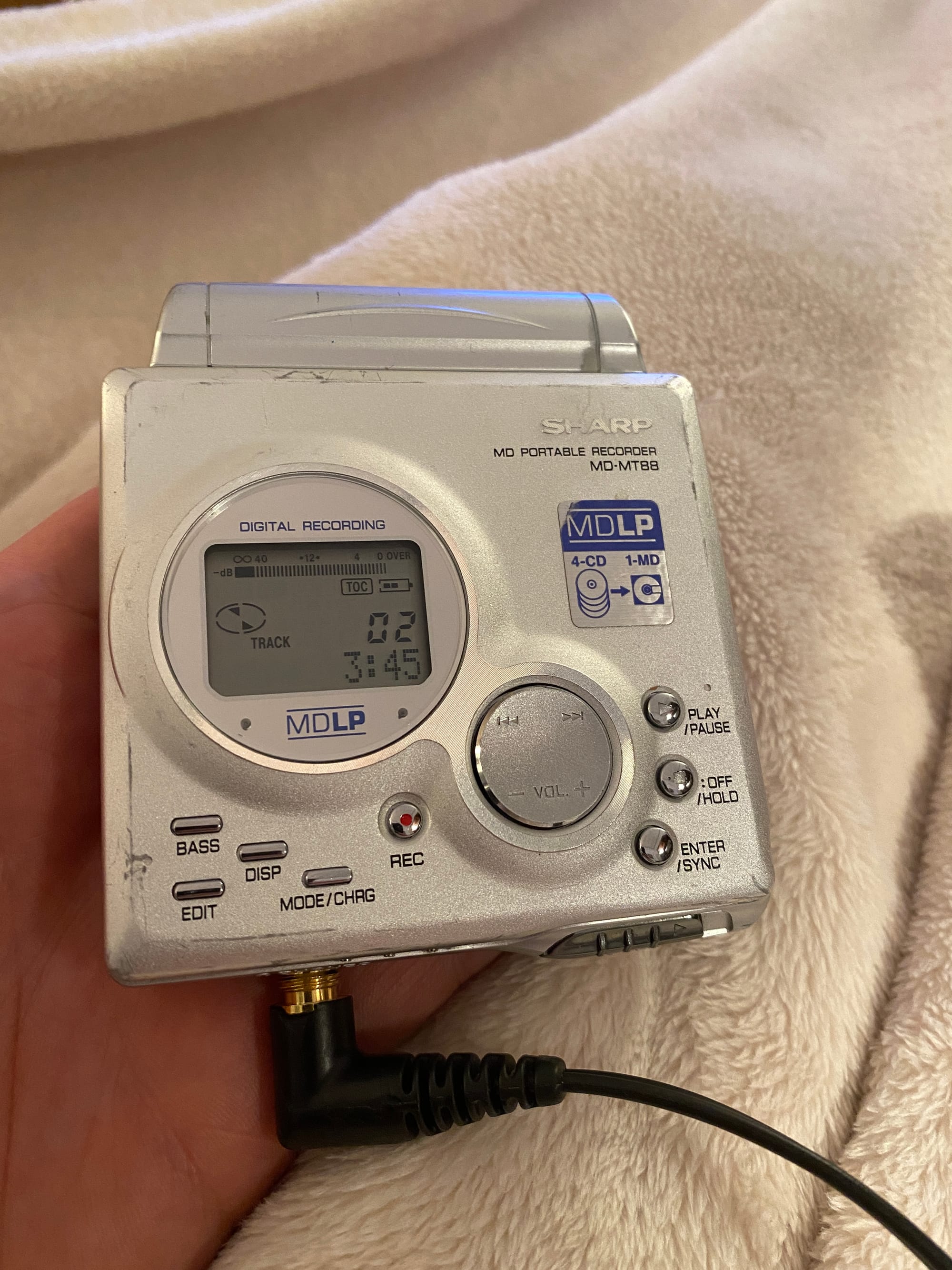
Also, I bought my first one again (the Sharp MT-DR99 in blue) as defect from a guy in Belgium for 40€. My plan was to make this one to work again as my main Minidisc Player.
Looking at it, the error message was the usual "can't READa", which indicates, there might be a problem with the sledge or other moving parts.
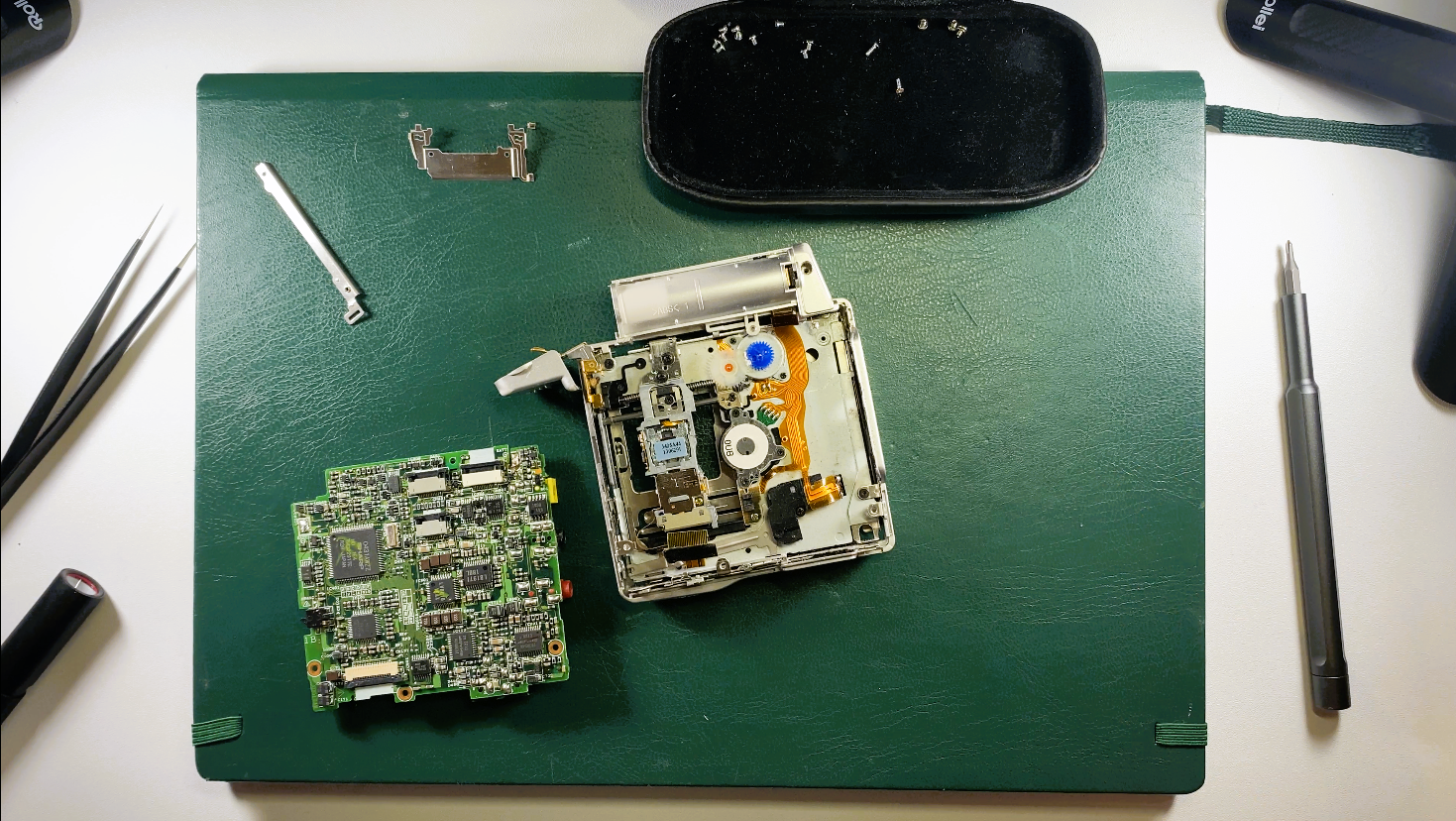
This was lots of fun! I opened the recorder - and to my surprise, there was a lot of sand in it...
I practiced to use tweezers properly and cleaned out all of the sand. Possible leakage of battery can be cleaned with isopropyl alcohol - done. Lastly, the bars on which the sledge slides back and forth got a bit of lube and then I put everything back together.
And...
Repairing another Sharp MD-MT99 Minidisc Recorder
I was lucky, as the recorder was back working again. What a great success! Now, that I have a player (yes, technically a recorder, but it plays back perfectly), the next step would be to get empty MDs to record onto. Looking at a classified website, I was able to find unused Sony Neiges. So I bought all of them. I could find.
Additionally, I was able to acquire a huge package of 50(!) unopened brand new Sony Neige MDs from an office, which apparently used Minidiscs record dictations. Another great success. To this day, I still have 20 unopened Sony Neige MDs and I don't have any intend to open them just yet 😄
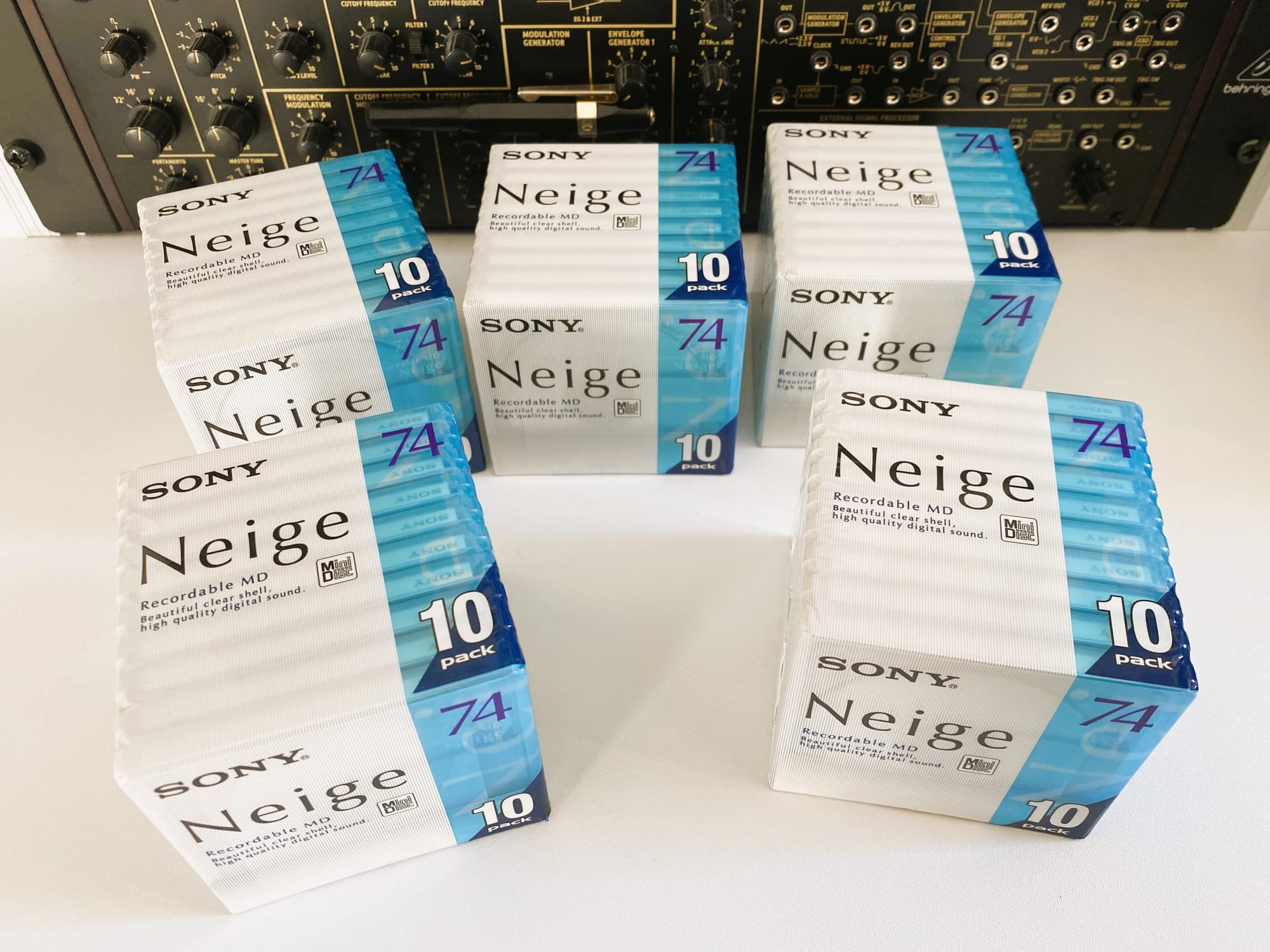
Next part is the streamlining of the recording-process, so to get music onto Minidscs. This is actually also a story on its own.
As I am very interested in music in general and also producing music, I own a special desk, which provides space to screw in 19" rack equipment. Looking at each and every piece of Minidisc-equipment on minidisc.org, I came across 19" Minidisc-Recorders, produced by Sony...
Well, of course. Not available in Europe. So I bought one from Japan, the Sony, MDS-E10, which apparently was a professional recorder, used by radio stations etc.
After waiting for two weeks, the package arrived.
With great enthusiasm, I opened the box, ready to do a first round of testing. I plugged the recorder into a power socket, switched it on, and boom. All the enthusiasm was gone.
I did not realize, as this is a Japanese unit, of course it is using a different current. 100 volt instead of the 230 volt, we use here in Germany.
Therefore, if you buy stuff from Japan, make sure, you are using the correct amount of current...
Nevertheless, I though, let's open up the recorder and check, if I'm lucky and it has a now broken fuse in it. Said and done. Yes, the internal power brick housed a fuse. But more interestingly, I discovered jumpers, which you can apparently solder into different configurations. There are three options, one for Japan (100V), one for USA(120V) and one for the rest of the World (230V). I soldered the jumper into the most promising place, replaced the fuse, I bought at a local electronics dealer, and luckily, with this I brought the recorder back to life.
I screwed it into my desk right above the Behringer K-2 synth, hooked it all up and it was just amazing.
I plugged it into my monitors, as well as my computer, and with this, I am able to listen to Minidisc through large speakers and if I want to record anything from my computer, I can do that, too.
I spent several nights recording music onto Minidiscs since then and it is such a pleasure. You need to first listen to a track, set the levels correctly, hit record and you can edit the title in the recorder, while it is recording. Very efficient.

After a while, I reflected around my setup and I started to ask myself, how can I streamline the process of recording my existing MP3 and FLAC albums onto Minidiscs even further? Shure, listening to entire albums while "typing in" all the titles through turning the wheel is one option, but I remembered the other way, called NetMD.
Out of interest, I looked up at minidisc.org, if Sharp also had some NetMD players. As you might have already understood, I do prefer the Sharps, as they sound a bit more warmer to me, or my ears are simply used to their sound. Nevertheless, I purchased a used Sharp IM-DR420H, which is a NetMD recorder having a USB-interface but also a dedicated mic-in.
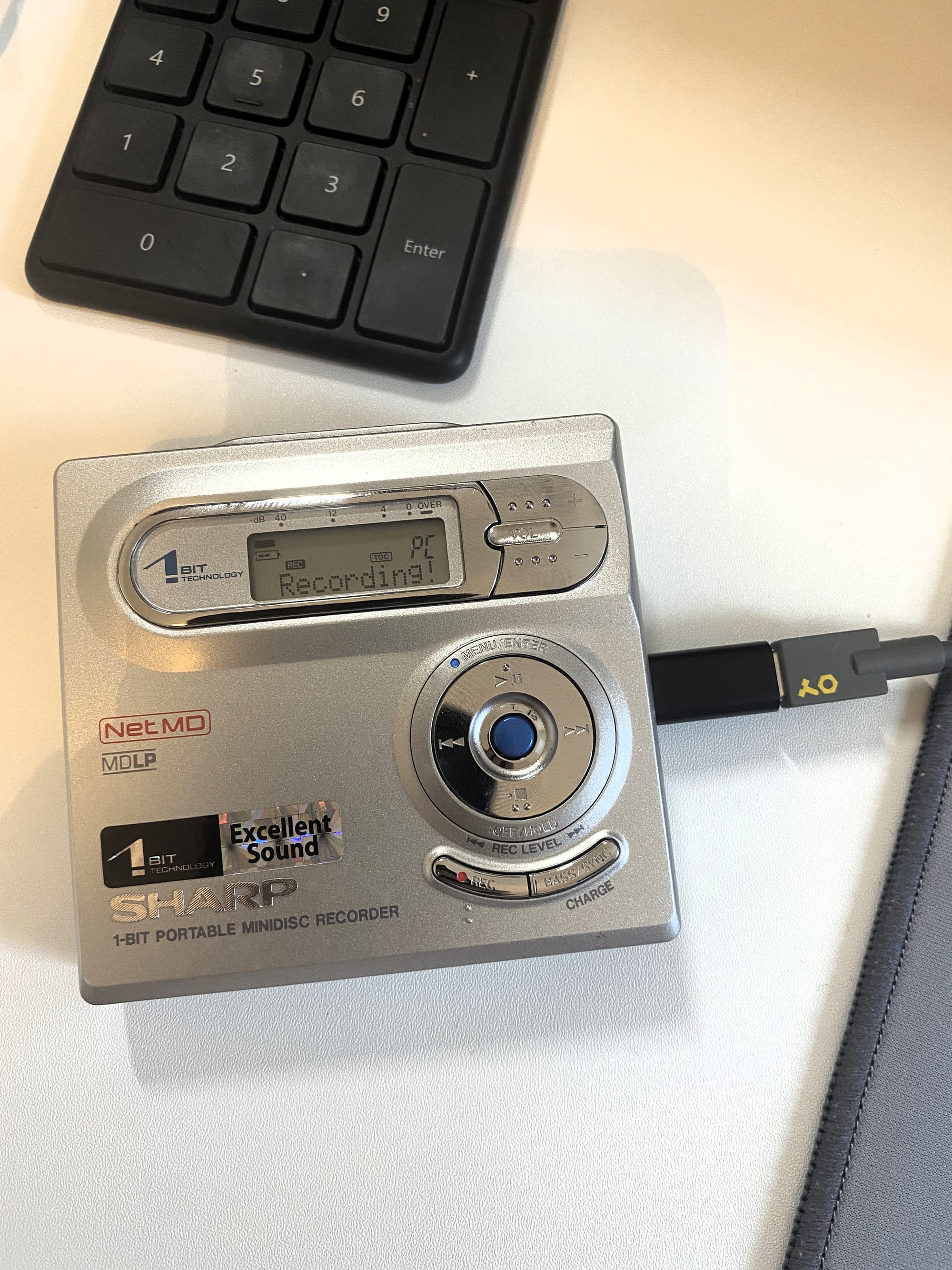
I googled how to use NetMD in 2022 and of course, you could still use Sony's Sonic Stage software, which only runs on Windows XP. That would have meant, re-creating an old machine with XP on it, getting Sonic Stage to work, copy the files onto the old machine to drop them onto the recorder. Too much effort.
However, there are very clever people out there. Stefano Brilli for example, who created Web Minidisc Pro. This is a browser application, helping you to copy your files onto Minidiscs. Just brilliant! With this, it is possible to simply use your modern browser to connect to your NetMD-Recorder! How cool is that? The only thing, you need to do is to install some generic drivers and then you're good to go.
You can check out Web Minidisc here.
After watching some videos from Fauxtaku Lounge, an advertising photographer from Japan, who is also very much into Minidisc and audiophile music-equipment, he pointed some very important fact out: The Sharp IM-DR420, as well as their later Auvi models, have a strange audio-out: a 4-pole TRRS one, instead of the standard, 3-pole TRS out. This is a special plug with three rings, instead of two. This results in not having a as-good-as stereo-separation as using a standard 3-pole TRS out. Hm... What to do now.
Googling further, it turns out, Sharp more or less has equipped their Minidisc Players and Recorders back then with a 3,5mm balanced output. Cool! However, now the tricky part. Finding balanced headphones, coming with a 3,5mm TRRS plug (in the correct wiring) is really a challenge.
Summarizing probably more than half a year of googling, I found the NiceHCK NX-7 mkIII In-Ear-Monitors. You can purchase those from AliExpress with the option to get them with a 3,5mm balanced TRRS plug! And apparently, those are the only ones out there right now. Even the cable itself may cost you more than the 150€, I paid, as such cables don't exist and they need to be custom built for you.
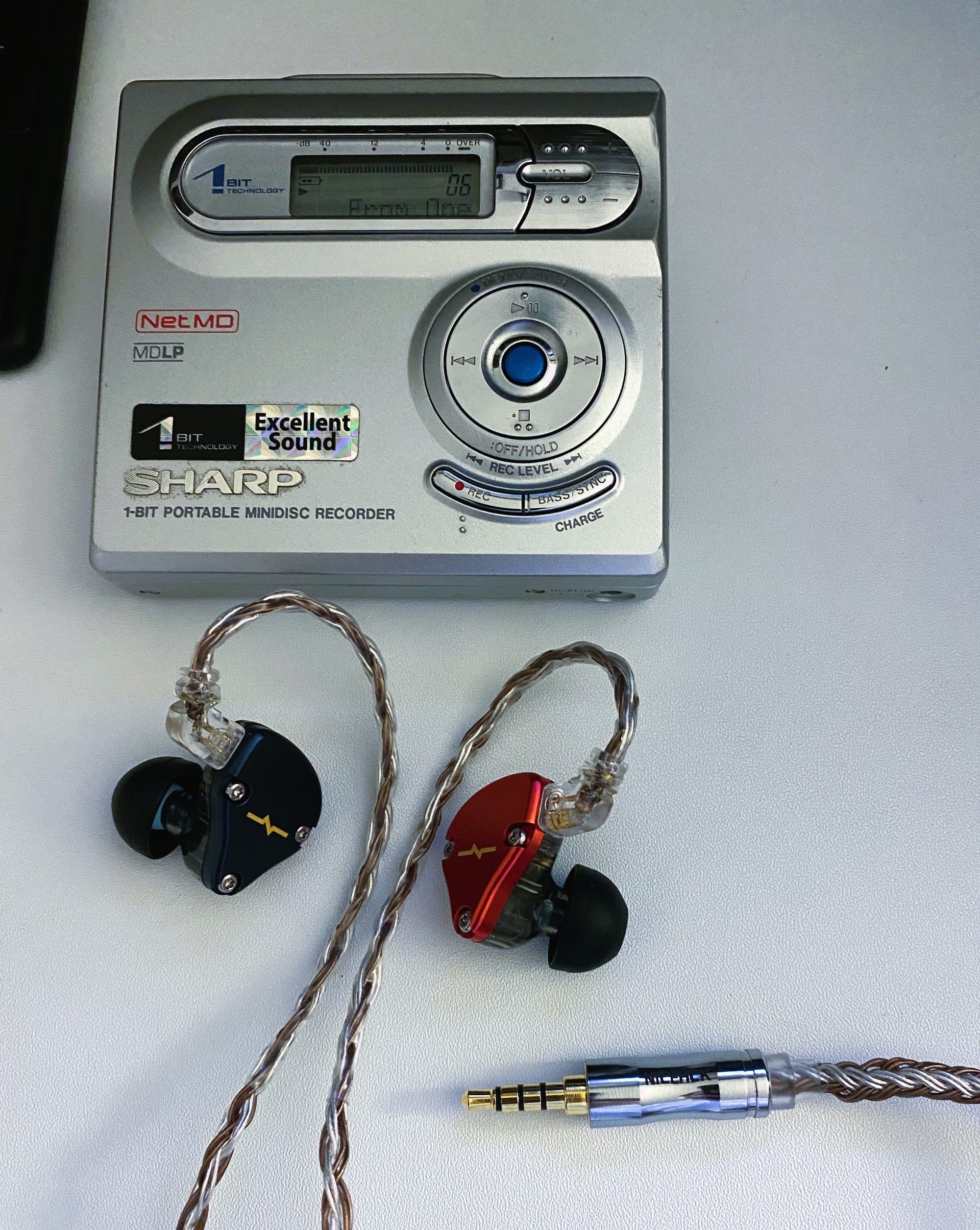
This brings us to 2024!
I still listen to my Minidiscs, I love the sounds, I really appreciate the physical interaction, selecting an album, sliding it into the player... it's just nice. For proper storage, I got a nice 3d-printed tray, keeping all my Minidiscs together. I got it through Etsy.
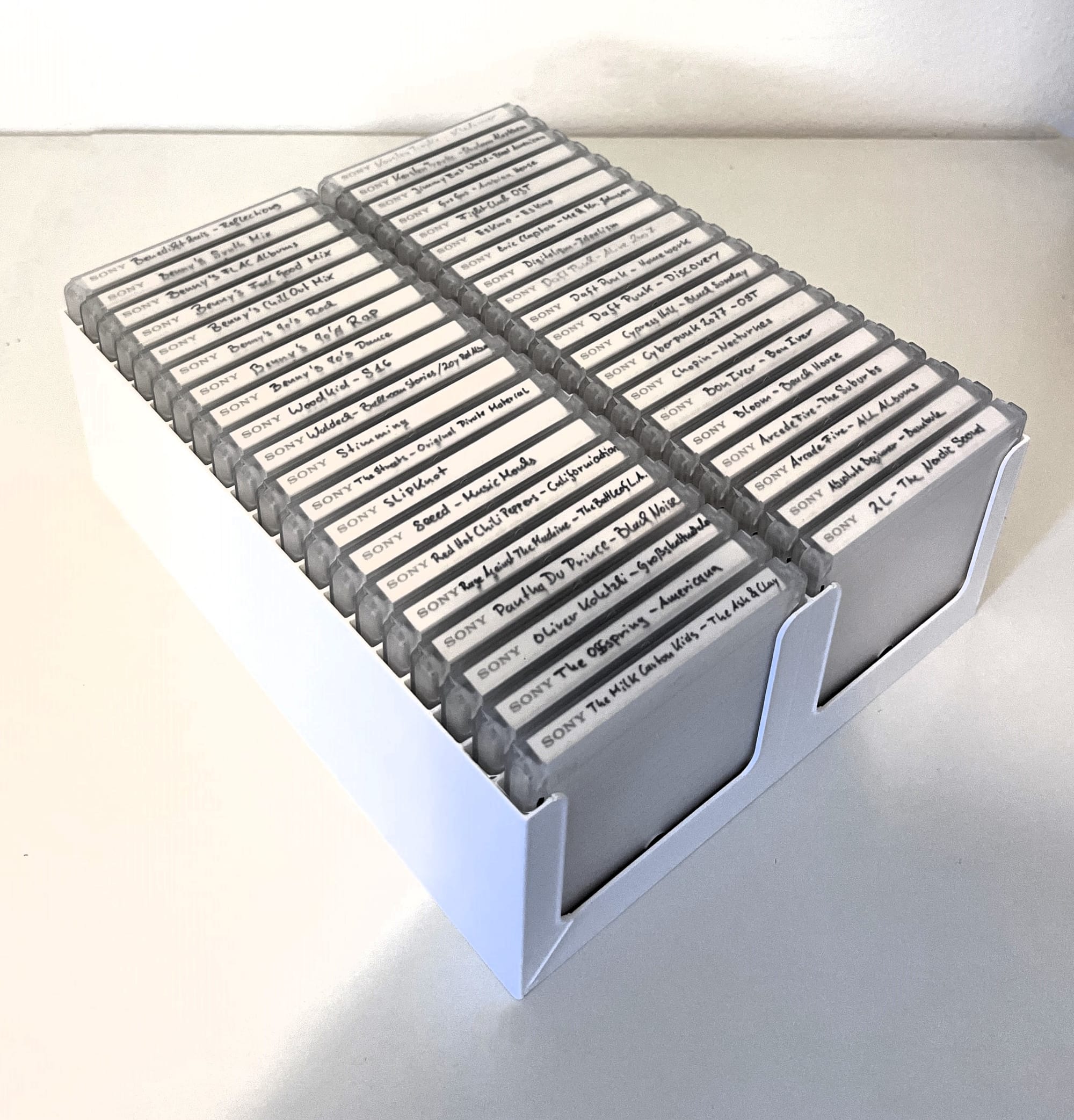
Of course, there are questions, to which I don't have answers right now. For example: Is Sharp's 1bit technology the same as Sharp's Auvi? If you know, please to let me know!
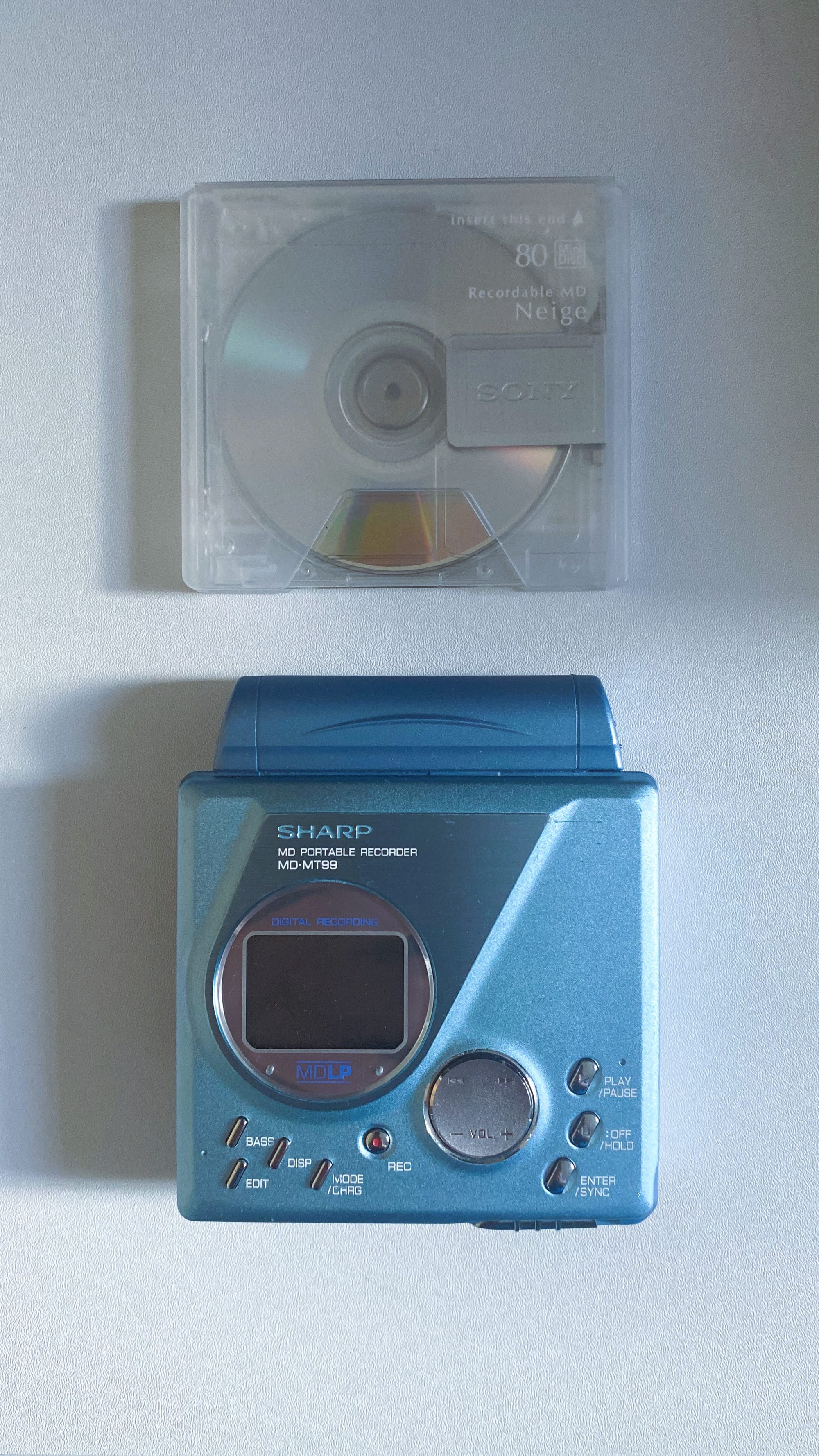
Lastly, another tip: Sometimes, plastic displays get scratches. However, it can be repaired easily. I use polywatch, which is a paste, you polish into the scratch and my applying a little pressure, the result is simply stunning. The scratches just disappear. Below, you can find the before and after of removing a scratch in the display of my Sharp IM-DR420H:
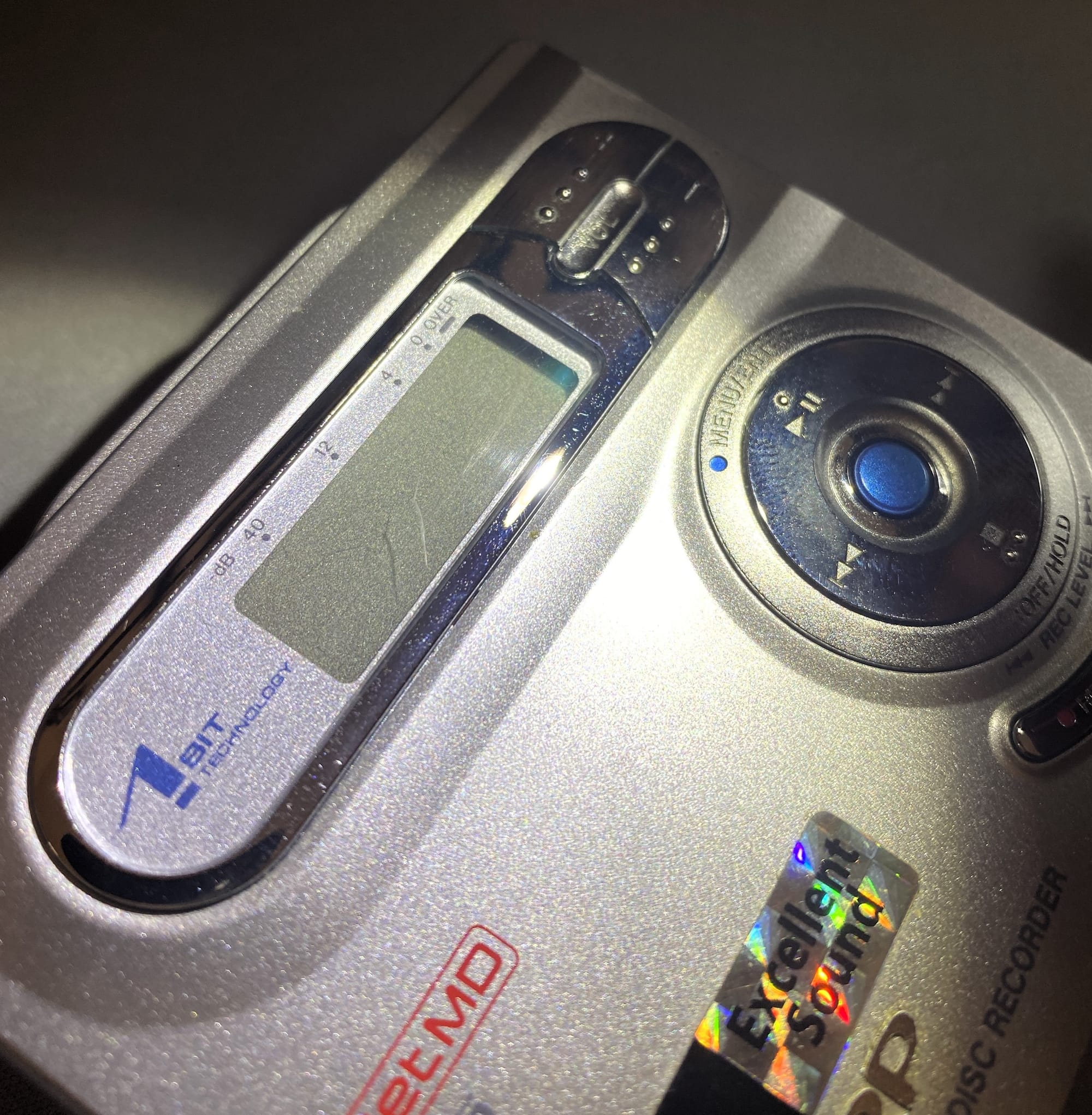

And this is the end of my Minidisc-story so far. I'm sure, there is more to come. Thanks for reading this far ;)